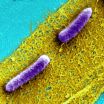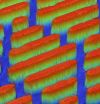(Press-News.org) This news release is available in Spanish.
Obesity and overweight affect more than half of the population in our Community. Excess weight causes important alterations in the organism, one of which affects liver function. Fat accumulates in the liver producing hepatic steatosis which, in certain circumstances, causes inflammation, fibrosis and finally, cirrhosis. To date, the most reliable method for determining hepatic fat has been hepatic biopsy. Imaging techniques such as abdominal ecography detect it but are less precise for determining the quantity of fat.
But a study undertaken by the research team led by Luis Bujanda, Professor of Medicine at the University of the Basque Country (UPV/EHU) and in charge of the Area of Research into Hepatic and Gastrointestinal Diseases at the Biodonostia Health Research Institute, has shown that magnetic resonance is a good method - better still than hepatic biopsy - for detecting fats in the liver and for quantifying them. The work has been published in the BMC Medicine, one of the most important journals in the specialisation and coordinated by doctors Jesús Bañales of the Biodonostia HRI, and Raúl Jimenez of the Department of Surgery, Radiology and Physical Medicine at the UPV/EHU's Medicine and Odontology Faculty. The study also has had the participation of researchers from the Department of Nutrition and Food Sciences of the UPV/EHU's Pharmacy Faculty, from the Surgery, Digestive System and Pathological Anatomy Services at the Donostia University Hospital, together with Osatek (the Basque Public Health Department's Imaging Diagnosis Service).
The research was undertaken with 97 obese patients and 32 patients with other hepatic pathologies, and who had been subject to surgical intervention. The quantity of fat in the liver was measured using three different methods; magnetic resonance, hepatic biopsy and the biochemical determination of fat employing the Folch method. Patients were subject to magnetic resonance the day prior to surgery and a sample of liver was obtained during the surgery.
"Magnetic resonance is a very useful technique to determine the presence of fat or not in the liver, the quantity of the same and in order to evaluate the efficacy of treatment applied over a long period. It is possible that in the future we will be able to determine, apart from fat, the degree of inflammation and hepatic fibrosis.", stated Jesús Bañales, researcher at Biodonostia HRI.
The article, recently published in the BMC Medicine journal, ratifies the previous work undertaken in animals and published by the same research team a year ago in which it was observed that the quantification of hepatic fat was very precise when using magnetic resonance.
INFORMATION:
Bibliographic Reference
Novel equation to determine the hepatic triglyceride concentration in humans by MRI: diagnosis and monitoring of NAFLD in obese patients before and after bariatric surgery. Raúl Jiménez-Agüero, José I Emparanza, Adolfo Beguiristain, Luis Bujanda, José M Alustiza, Elisabeth García, Elizabeth Hijona, Lander Gallego, Javier Sánchez-González, María J Perugorria, José I Asensio, Santiago Larburu, Maddi Garmendia, Mikel Larzabal, María P Portillo, Leixuri Aguirre and Jesús M Bañales. BMC Medicine 2014, 12:137. Doi: 10.1186/s12916-014-0137.
Magnetic resonance helps to detect and quantify fat in liver
2014-09-17
ELSE PRESS RELEASES FROM THIS DATE:
Car hacking: The security threat facing our vehicles
2014-09-17
The car of the future will be safer, smarter and offer greater high-tech gadgets, but be warned without improved security the risk of car hacking is real, according to a QUT road safety expert.
Professor Andry Rakotonirainy will speak at the Occupational Safety in Transport Conference (OSIT) on the Gold Coast on September 18-19 on the security threat facing drivers as vehicles become computers on wheels.
Professor Rakotonirainy, from QUT's Centre for Accident Research & Road Safety - Queensland (CARRS), has researched the security systems of existing fleet, future ...
Survey finds benefits, risks of yoga for bipolar disorder
2014-09-17
PROVIDENCE, R.I. [Brown University] — Right now no one can say whether yoga provides clinical benefits to people with bipolar disorder, but in a new article in the Journal of Psychiatric Practice, researchers report survey responses they gathered from scores of people with the condition who practice yoga. What the collective testimony suggests is that yoga can be a substantial help, but it sometimes carries risks, too.
"There is no scientific literature on hatha yoga for bipolar disorder," said lead author Lisa Uebelacker, associate professor (research) of psychiatry ...
Cape Cod saltmarsh recovery looks good, falls short
2014-09-17
PROVIDENCE, R.I. [Brown University] — After decades of decline, grasses have returned to some once-denuded patches of Cape Cod's saltmarshes. To the eye, the marsh in those places seems healthy again, but a new study makes clear that a key service of the marsh – coastal protection – remains diminished.
"We've got the aesthetics back but the ecosystem function hasn't come back," said ecologist Mark Bertness, professor of biology at Brown and senior author of the study in the journal Biological Conservation. "The metric of a recovered habitat should not be 'Does it look ...
Recruiting bacteria to be technology innovation partners
2014-09-17
For most people biofilms conjure up images of slippery stones in a streambed and dirty drains. While there are plenty of "bad" biofilms around – they even cause pesky dental plaque and a host of other more serious medical problems – a team at the Wyss Institute for Biologically Inspired Engineering at Harvard University sees biofilms as a robust new platform for designer nanomaterials that could clean up polluted rivers, manufacture pharmaceutical products, fabricate new textiles, and more.
In short, they want to give biofilms a facelift, and have developed a novel protein ...
Phthalates heighten risk for childhood asthma
2014-09-17
Researchers at the Columbia Center for Children's Environmental Health at the Mailman School of Public Health are the first to demonstrate an association between childhood asthma and prenatal exposure to two phthalates used in a diverse array of household products. Results appear online in the journal Environmental Health Perspectives.
Children born to mothers exposed during pregnancy to higher levels of the chemicals, butylbenzyl phthalate (BBzP) and di-n-butyl phthalate (DnBP) had a 72 percent and 78 percent increase in risk of developing asthma between age 5 and 11, ...
New study examines the impact of socioeconomic position & maternal morbidity in Australia
2014-09-17
The risk of severe maternal morbidity amongst women in Australia is increased by lower socioeconomic position, suggests a new study published today (17 September) in BJOG: An International Journal of Obstetrics and Gynaecology.
Australians generally enjoy high standards of living; however, existing research has concluded that health disparities exist, in particular between indigenous and non indigenous Australians.
This case-control study aimed to explore the independent impact of socioeconomic position on severe maternal morbidities associated with direct maternal ...
A greater focus on socially disadvantaged women is needed to improve maternity care in England
2014-09-17
Women from lower socioeconomic groups in the UK report a poorer experience of care during pregnancy and there needs to be a greater focus on their care, suggests a new study published today (17 September) in BJOG: An International Journal of Obstetrics and Gynaecology (BJOG).
Differences in health outcomes amongst different socioeconomic groups have been demonstrated in many areas and have provided the focus for national initiatives in the UK to reduce the observed inequalities.
The Oxford University study, funded by the National Institute for Health Research, explores ...
NAMS issues first comprehensive recommendations on care of women at menopause and beyond
2014-09-17
CLEVELAND, Ohio (September 17, 2014)—The North American Menopause Society (NAMS) has published its key, evidence-based recommendations for the comprehensive care of midlife women—on everything from hot flashes to heart disease. The special feature, "The North American Menopause Society Recommendations for Clinical Care of Midlife Women," was published online today in the Society's journal Menopause. This is the first, comprehensive set of evidence-based recommendations for the care of midlife women freely available to all clinicians who care for women at this stage of life. ...
Sharks' skin has teeth in the fight against hospital superbugs
2014-09-17
Transmission of bacterial infections, including MRSA and MSSA could be curbed by coating hospital surfaces with microscopic bumps that mimic the scaly surface of shark skin, according to research published in the open access journal Antimicrobial Resistance and Infection Control.
The study modelled how well different materials prevented the spread of human disease bacteria through touching, sneezes or spillages. The micropattern, named Sharklet™, is an arrangement of ridges formulated to resemble shark skin. The study showed that Sharklet harboured 94% less MRSA bacteria ...
Violent origins of disc galaxies probed by ALMA
2014-09-17
An international research group led by Junko Ueda, a Japan Society for the Promotion of Science postdoctoral fellow, has made surprising observations that most galaxy collisions in the nearby Universe — within 40 million light-years from Earth — result in so-called disc galaxies. Disc galaxies — including spiral galaxies like the Milky Way and lenticular galaxies — are defined by pancake-shaped regions of dust and gas, and are distinct from the category of elliptical galaxies.
It has, for some time, been widely accepted that merging disc galaxies would eventually form ...




